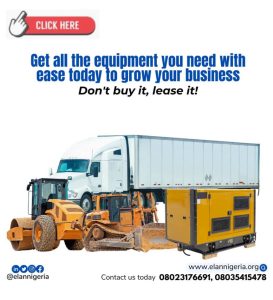
As a lessor (the owner of the asset), leasing business can be sourced through the following are the ways:
- By direct marketing of the Lessor’s services; the Lessor can approach a potential Lessee (the customer that needs the asset) for business;
- The Lessee initiating the approach to a Lessor for lease facility;
- Through sales-aid leasing whereby the supplier of equipment makes initial enquiries, and
- Through financial intermediaries e.g. brokers, consultants acting on behalf of either the Lessor (owner of an asset) or Lessee (user of an asset).
Irrespective of the source of business, you must assess the transaction properly, to ensure that all credit policies and criteria are met by the lessee. The processes involve the following:
i What is the reason for wanting to lease the asset?
ii. What is the cost of the asset in relation to the lessor’s critical mass or resource capacity?
iii. What is the expertise level of the lessee in handling the asset in question?
iv. In view of the potential Lessee’s past performance and payment record, would it be able to meet its lease obligations?
v. What is the quality of management in the Lessee’s organisation in terms of its ability to run a successful venture?
vi. Is the Lessee really sure that what he is asking for is what he actually needs to do the job?
Having passed through these initial tests in terms of positive responses, you now requests for additional information and data from the lessee including:
- Formalising the request through a written application for the facility and the amount involved from the Lessee.
- The certificate of registration / incorporation of the Lessee’s firm.
- The Articles and Memorandum of Association of the Lessee.
- The Lessee’s unqualified audited accounts for 3 to 5 years immediately preceding the application.
- Six months or more bank statements of the lessee immediately preceding the application.
- The Lessee’s cash flow projections during the lease term.
- Background information on the shareholders, qualifications, experience and responsibilities of the directors and top management of the lessee’s company.
- Description of the business of the Lessee, including its market share, sources of raw materials and other inputs, manufacturing processes, stability of the business in the light of changes in economic conditions, major suppliers and customers, material contracts, pending litigation, if any.
- Current invoice showing the price of the asset to be leased.
- Detailed technical specifications of the asset, its year of manufacture, model, make, serial number, engine and chasis number and expected economic life of the asset.
- All outstanding debt obligations of the Lessee, including leases already undertaken, to creditors, bankers and directors, which may be verified through enquiries.
- Lessor’s impression of the Lessee’s operations and level of seriousness through visit to his premises, factories, warehouses and major distribution outlets.
Further details about on strategies for success in this fast growing industry, do not hesitate to contact the experts and learn from the best. Visit the Secretariat or call 08023176691, 08023179048, info@elannigeria.org for further engagements

